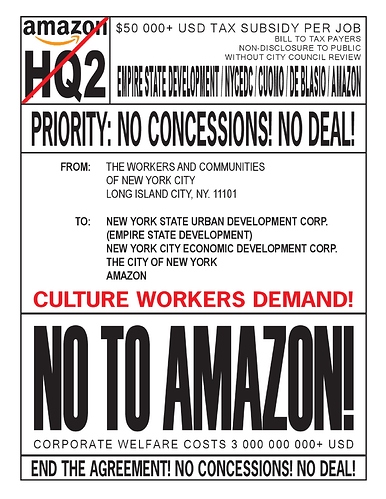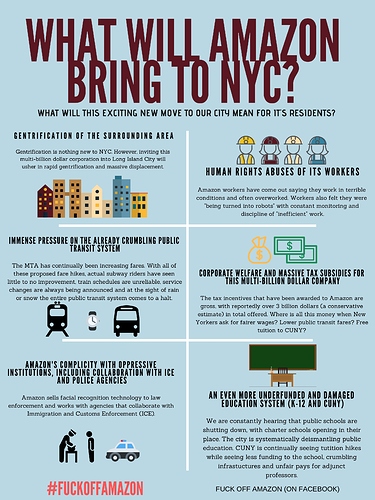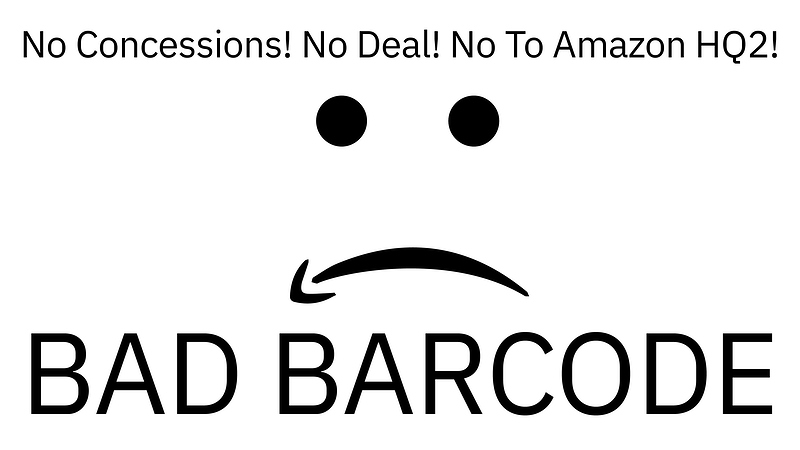Image credit: Kenneth Pietrobono
The following text is the Introduction to the research dossier “BAD BARCODE: NYC Cultural Workers Against Amazon.”
We are BAD BARCODE, a group of cultural workers of NYC that have mobilized in opposition to Amazon’s proposed new headquarters (HQ2) in Long Island City, Queens. We recognize that the battle against gentrification, techno-finance, rezoning, development, dispossession, and for the rights to affordable housing and rent control, functioning infrastructure, equitable education, and sustainable social services are being fought for by many anti-gentrification groups, anti-BID groups, tenants’ associations, unions, cultural organizations, community gardens, co-ops, immigrant communities, and individual citizens all across this city. They are now mobilized to bravely resist the stealth entry of Amazon HQ2 into Queens.
Our report on Amazon in New York follows from this work already underway, and is written in solidarity with them. We are happy to announce that we have endorsed Fuck Off Amazon in NYC’s Principles of Engagement and Statement, along with Amazons Against Amazon, Brooklyn College Student Union, Craash: An Asian American Student Union, CUNY Struggle, CUNY Not HQ2, Decolonize This Place, Politics Reborn, Queens Anti-Gentrification Project, Sunset Park for a Liberated Future, and Take Back The Bronx.
We extend our deepest support to other groups on the ground such as: BAN (Brooklyn Anti-Gentrification Network), CAAAV Organizing Asian Communities–Chinatown Tenants Union, Desis Rising up and Moving, Make the Road NY, MayDay Space: Derecho A Techo, Queens Democratic Socialists of America, Progressive Hacknight, NYC DSA Tech Action Working Group, Tech Workers Coalition, Queens Neighborhoods United, Queensbridge Tenants Association, Whole Worker, and all those others organizing in their communities in this fight.
As residents of New York working in the sectors of education, culture, organizing, film and television, technology, publishing, and small business, we have long been leveraged as the “face” of New York’s cultural life by city officials and big business in their pursuit of an anti-poor agenda of gentrification, privatization, and wealth laundering/redistribution to the already wealthy. Real estate developers and city officials work hand in hand to exploit our communities and to extract from them, by “showcasing” the neighborhoods we have populated to speculative real estate powers—the spaces where we have worked and lived alongside the historically working class, immigrant, and communities of color who built them, and who continue to be pushed further into precarious and peripheral living and working conditions.
Image credit: Fuck Off Amazon
Mayor Bill De Blasio claims the arrival of Amazon “validates our progressive policies”1 while Governor Mario Cuomo patronizingly tells us “there is no large development project that is accomplished without controversy.”2 The historical amnesia professed by the city officials who originally invited Amazon in October 2017 (e.g., State Senator Michael Gianaris) is a farce, and we must hold all those officials accountable as they backtrack in the face of the vast opposition to this deal by the communities that will be affected. Controversy arrives because communities can see their further extinction approaching, not because “debate” is a natural, gentle corollary (as Cuomo’s neoliberal appeal claims) or because “tough decisions” need to be made. At least since the time of Robert Moses and his destruction of major swaths of this city, particularly communities of color; at least since the red-lining of the 1930s; and continually for at least the last four decades, communities know what happens when “development” is forced down our throats—a redistribution of wealth from the most vulnerable of us to those already reaping astronomical profits, such as Jeff Bezos, the richest man in the world.
As the spectacle of the “artist city” has been exploited to cultivate an image of New York that none of its artist residents or their neighbors can afford, numerous and cross-disciplinary groups have consistently pushed back against the gentrification of the Lower East Side, Williamsburg, Dumbo, Atlantic Yards, Hudson Yards, and many neighborhoods in Queens.3 We have collectively scored small victories (typically in the form of minor concessions), but the overall war of expropriation is being won by a brutally rapacious real estate industry, a job-destroying financial sector, an inflated startup culture bubble, all assisted by a corrupt and inefficient city government, by corporate welfare, and the gentrifying citizens of the finance, big tech, and media industries brought here to enjoy a leisure city-as-playground for those with six-figure salaries.4 These citizens, many who will move here for Amazon jobs, or move from other tech firms, leaving vacancies for others in their place, are the only ones who will benefit from the techno-financial invasion for which Amazon’s proposed New York Headquarters (Amazon HQ2) is only the apex. Just as Amazon announced their new headquarters to be split between NY and Virginia, Google also announced they are investing in a new one-billion-dollar campus in New York City, which will include more than double its current headcount.5
It comes as no surprise to us that part of what Amazon is “offering” in its takeover of Long Island City are vague promises to maintain and promote the artistic community. It is for these reasons that we have co-sponsored a pledge penned by the Artist Studio Affordability Project, which rejects any Trojan horse outreach from Amazon to arts communities. We, as artists, critics, teachers, curators, administrators, writers, poets, artisans, editors, and other cultural workers of New York, will never accept Amazon’s instrumentalizing tactics, nor concede to false promises meant to sweeten the deal for us producers of culture. As Shellyne Rodriguez writes in her excellent text “How the Bronx was Branded”:
In New York City, artists experience this crisis of the disappearance of space alongside other New Yorkers in many ways … Like many other major cities, New York has been reorganized into roommate-driven living systems where we barely restore our bodies, in order to repeat the process of sustaining our lives so we might continue to prop up the structures that continue to allot less time to actively pursue leisure or, more importantly, to organize and agitate for our freedom.6
Of course, artists’ own need for affordable rent have made us the proverbial “first wave” of gentrification. This has not been the result of our own choice, but rather of these structures of heedless development. Whenever and however we can, we have confronted big capital. We will do whatever we can to oppose this, and we will insist, at the very least, that this not be done in the name of “the visual arts.”
Image credit: Azon Mano with Bad Barcode
The Crystal City half of HQ2 comes with a potential “sweetener” of a $10 billion defense deal that Amazon was “pre-approved for.”7 What then did New York give up to entice “brand” Amazon? QNU Queens Barrios (a broad-based community working group) said in a statement:
In a city with such wealth, we still have over 65,000 families homeless, NYCHA is 16 billion dollars in debt—its residents and many of our neighbors are living in mold-infested hazardous buildings, experiencing eviction, landlord terrorism, and crumbling infrastructure. We are told by city officials that this is because there are not enough tax revenues to repair these social dilemmas. How did the city suddenly come up with a plan to give such significant tax breaks and incentives to a corporation led by the richest man in the world?8
In cooperation with certain New York City and New York State politicians, Amazon is pushing elements of the deal at breakneck speed to avoid community oversight and input, as they know genuine involvement from the communities this will affect have the power to force it to stop.9 In the aforementioned October 16, 2017 invitation letter to Amazon, numerous city and state officials welcomed the company.10 Many of the most “vocal” current detractors of the deal—now that it is clear that most of their constituents are in uproar over it—have “changed their minds.” Most prominently, State Senator Mike Gianaris has supposedly had a change of heart.11
Knowing that he has to compete with genuinely progressive politics, such as those preached and practiced by young and new elected officials like Representative Alexandria Ocasio-Cortez, Gianaris and others have pretended they were fooled. Do not let them feign support for the communities they ostensibly represent. They knew exactly what they were signing.
Protesters led by Make the Road New York, New York Communities for Change, The Retail, Wholesale and Department Store Union, and CAAAV recently declared, as they engaged in a direct action at the Amazon bookstore in Herald Square: “This will impact Queens first. Queens residents should have a voice about what happens in their borough.”12 Precarious workers suffering under the current waves of austerity and hyper-capitalism have continued to globally protest Amazon, a company that now takes a visible role in busting unions and strikes. This is a company that collaborates with repressive police agencies,13 and actively fights against affordable housing for their workers and those living in the communities they disrupt (most heinously clear in Bezos’s opposition to affordable housing reform in Seattle, a city ravaged by Amazon’s presence). In an effort to network with all our New York communities to hold city and state politicians accountable, we have compiled some key data about the negative impact of HQ2 on New York—the document includes a section detailing HQ2’s “Impact on New York” which analyzes the deal with regards to: 1) Political Corruption, 2) Tax Revenue, 3) Housing, 4) Workers, 5) Transport, 6) Surveillance, 7) Retail, 8) Environment, and 9) Education. Afterwards, we present “Experience of Other Cities” and “Resistance: Our Next Steps.” The document will continue to be updated as news develops, and the most recent report can be found on our website: badbarcode.net.
Email us: studio.bad.barcode@gmail.com
Facebook: https://www.facebook.com/badbarcodenyc
×
2 Andrew Cuomo, “Op-Ed from Governor Andrew N. Cuomo,” November 19, 2018.
3 See a thorough list of many of these groups compiled by the Chinatown Art Brigade: http://www.chinatownartbrigade.org/resources/.
4 Certain media sources have claimed that the proposed average salary for workers at HQ2 may be around $150,000—clearly this does not include those thousands of warehouse workers that will be hired at “fulfillment centers” that Amazon is continuing to build in Staten Island. These workers are beginning to organize, notwithstanding Amazon’s long-standing union-busting practices. Bryan Menegus, “Amazon’s Aggressive Anti—Union Tactics Revealed in Leaked 45-Minute Video,” Gizmodo, September 26, 2018.
5 “Google to invest $1 billion in new campus in New York City,” CNBC .
6 Shellyne Rodriguez, “How the Bronx was Branded,” The New Inquiry, December 12, 2018.
7 Matt Taibbi, “Amazon’s Long Game Has Never Been Clearer,” Rolling Stone, November 14, 2018.
8 Queens Neighborhoods United, Twitter post, https://twitter.com/QueensBarrios/.
10 Letter to Jeff Bezos, October 16, 2017.
12 “Amazon HQ2 protesters swarm Herald Square bookstore,” AM New York.
13 Isobel Asher Hamilton and Ruqayyah Moynihan, “Amazon reportedly left police in Spain ‘dumbfounded’ by asking them to intervene in a mass warehouse strike and patrol worker productivity,” Business Insider, November 23, 2018. According to the article, Amazon similarly called on Spanish police to intervene in protests last July. “When workers went on strike on Prime Day in July, Amazon asked police to guarantee workers access across the picket line and to trucks carrying merchandise. The strikes in July resulted in clashes with police, including some arrests.”


